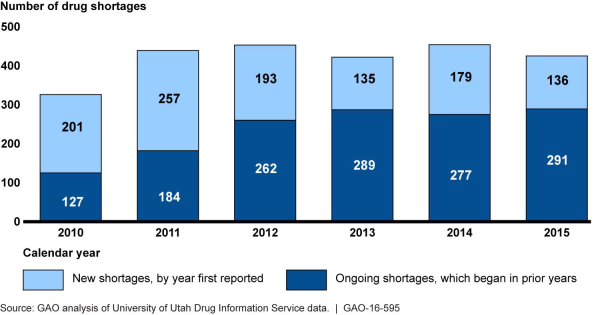Hot Topic
Drug Shortages: Causes and Implications for the Mohs Surgeon
By Mark Russell, MD, FACMS
Drug shortages continue to be a serious public health care concern. The threat of potential shortages as well as adverse patient outcomes related to actual drug shortages have prompted contingency planning and alternative management strategies by health care providers. It has also gained the attention of the Joint Commission, the government, and the media.1
National tracking of drug shortages began in 2001, with a significant increase in the number of shortages beginning in 2009.2 New drug shortages continue to be reported, although the number of new shortages each year has generally decreased since 2011. Meanwhile, since 2012, the number of ongoing shortages (shortages that began in prior years) has remained high with over 250 ongoing shortages each year from 2012 through 2015. 3

A drug product shortage can be defined as a supply issue that affects how the pharmacy prepares or dispenses a drug product or influences patient care when prescribers must use an alternative agent.3 The reasons for drug shortages in order of prevalence are: Manufacturing issues, delays/capacity issues, raw materials shortage, increased demand, loss of manufacturing site, and discontinuation of the drug.4
The pharmaceutical industry contains a number of drug manufacturers and suppliers. The production of drugs, however, is a business and thus subject to the pressures that influence businesses such as supply/demand, cost to manufacture, profit margin, quality demands, production-run scheduling, storage/distribution, and competition.3 While the Food and Drug Administration (FDA) has oversight of drug safety and quality, and works to mitigate drug shortages, there are factors that are outside of their control. In addition, they cannot require a pharmaceutical company to make a drug, make more of a drug, or change how much and to whom the drug is distributed.4
The typical drug in short supply is a generic sterile injectable product. Common classes of drugs affected by shortages include anesthesia medications, antibiotics, pain medications, nutrition and electrolyte products, and chemotherapy agents.2
Drug shortages especially relevant for the Mohs surgeon are injectable local anesthetics, sodium bicarbonate, and antibiotics. Strategies to manage shortages of local anesthetics include using the smallest amount possible, minimizing waste, diluting or mixing anesthetics, changing type of anesthetic (e.g. using mepivicaine or bupivacaine instead of lidocaine, using plain lidocaine instead of lidocaine with epinephrine), and use of alternative local anesthetics (e.g. diphenhydramine or bacteriostatic normal saline). 5
Mohs surgeons would be well-served by being aware of potential relevant drug shortages and proactively considering management strategies for times of limited supply. While stockpiling in response to a potential shortage is a natural temptation, it should be avoided as it could cause an artificial shortage. During shortages, manufacturers and distributors often allocate a product on the basis of past usage. An initial stockpile order generally has no effect on increasing an allocation.1
Information regarding drug shortages can be found at https://www.accessdata.fda.gov/scripts/drugshortages/ and at https://www.ashp.org/Drug-Shortages/Current-Shortages. These websites contain updated information including products affected, reason for shortage, related shortages, alternative available products, supplier data, estimated resupply dates, implications for patient care, and recommended management steps.
Drug shortages continue to be an on-going issue affecting many areas of medicine. The Mohs surgeon should be prepared with contingency plans and therapeutic alternatives to avoid interruption or compromise in patient care.
- American Society of Health-System Pharmacists website. https://www.ashp.org/drug-shortages/. Accessed 7/29/17.
- Fox ER, Sweet BV, Jensen V. Drug shortages: a complex health care crisis. Mayo Clin Proc. 2014 Mar;89(3):361-73.
- Drug Shortages: Certain Factors Are Strongly Associated with This Persistent Public Health Challenge, United States Government Accountability Office, Washington, DC (July 2016). GAO-16-595, pp 1–83. http://www.gao.gov/search?rows=10&now_sort=score+desc&page_name=main&q=drug+shortages. Accessed 7/29/17.
- U.S. Food and Drug Administration website. https://www.fda.gov/Drugs/DrugSafety/DrugShortages. Accessed 7/29/17.
- Kouba DJ, et al. Guidelines for the use of local anesthesia in office-based dermatologic surgery. J Am Acad Dermatol 2016;74:1201-19.)


